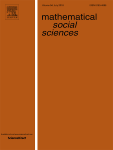Erel Segal-Halevi, Balázs R. Sziklai (2018): Resource-monotonicity and population-monotonicity in connected cake-cutting, Mathematical Social Sciences, in Press, link
Abstract
In the classic cake-cutting problem (Steinhaus, 1948), a heterogeneous resource has to be divided among n agents with different valuations in a proportional way —giving each agent a piece with a value of at least 1∕n of the total. In many applications, such as dividing a land-estate or a time-interval, it is also important that the pieces are connected. We propose two additional requirements: resource-monotonicity (RM) and population-monotonicity (PM). When either the cake or the set of agents changes and the cake is re-divided using the same rule, the utility of all remaining agents must change in the same direction. Classic cake-cutting protocols are neither RM nor PM. Moreover, we prove that no Pareto-optimal proportional division rule can be either RM or PM. Motivated by this negative result, we search for division rules that are weakly-Pareto-optimal —no other division is strictly better for all agents. We present two such rules. The relative-equitable rule, which assigns the maximum possible relative value equal for all agents, is proportional and PM. The so-called rightmost mark rule, which is an improved version of the Cut and Choose protocol, is proportional and RM for two agents.


